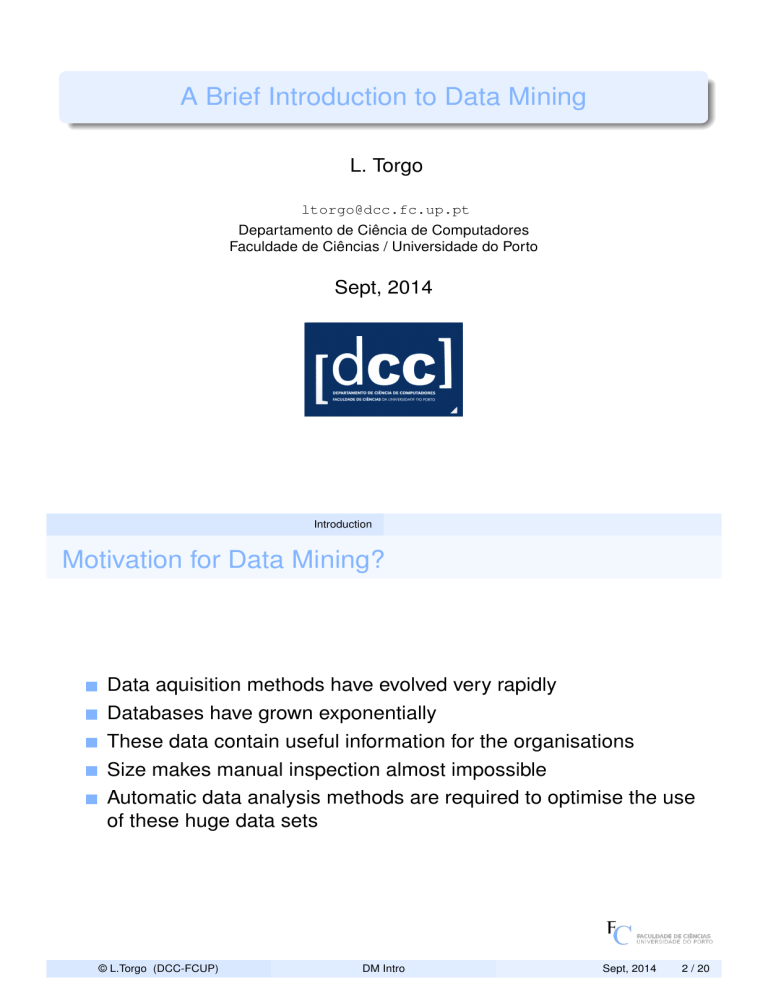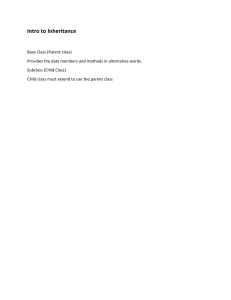
A Brief Introduction to Data Mining L. Torgo ltorgo@dcc.fc.up.pt Departamento de Ciência de Computadores Faculdade de Ciências / Universidade do Porto Sept, 2014 Introduction Motivation for Data Mining? Data aquisition methods have evolved very rapidly Databases have grown exponentially These data contain useful information for the organisations Size makes manual inspection almost impossible Automatic data analysis methods are required to optimise the use of these huge data sets © L.Torgo (DCC-FCUP) DM Intro Sept, 2014 2 / 20 Introduction What is Data Mining? A possible definition: Data Mining is the analysis of (often large) observational data sets to find unsuspected relationships and to summarise the data in novel ways that are both understandable and useful to the data owner in Principles of Data Mining (Hand et.al. 2001) © L.Torgo (DCC-FCUP) DM Intro Sept, 2014 3 / 20 Introduction Searching for relationships The process of searching for unknown relationships on the data usually involves several steps, like: determining the representation of the problem to use deciding how to quantify and evaluate/compare how well different representations of the relationships (models) fit the available data deciding which data management actions are required to implement the necessary algorithms efficiently © L.Torgo (DCC-FCUP) DM Intro Sept, 2014 4 / 20 Introduction An example Suppose we want to understand how the entrance grade of students at the university influences the number of years they take to finish their degree. We have collected a data set where each entry contains the grade of a student (a real number) and the number of years it took her(him) to finish the degree (an integer). We could decide to fit a linear regression model to the data set - a model of the form NrYears = α + β × Grade. The degree of fit of this type of models can be calculated by comparing the values predicted by the model against the collected values, and calculating some form of average prediction error As the computations required to obtain this type of models are rather simple, most probably no special data management actions would be necessary even for very large data sets. © L.Torgo (DCC-FCUP) DM Intro Sept, 2014 5 / 20 Introduction Data Mining and Knowledge Discovery in Databases Data mining is sometimes taken as one of the steps of the process of knowledge discovery Data Data Pre­Processing Post­Processing Data Mining Pattern filtering Visualisation ● Interpretation of results ● etc. ● Feature selection ● Dimensionality reduction ● Normalization ● etc. ● ● Fonte: Introduction to Data Mining, Tan et.al. (2006) © L.Torgo (DCC-FCUP) DM Intro Sept, 2014 6 / 20 Type of Data Sets Data Sets A data set is a collection of measurements taken from some environment. In the simplest case, we have p measurements for a set of n objects, i.e. a data matrix of dimension n × p. The n rows represent the objects for which we have collected data. The p columns represent the measurements that were made for each object. The rows of the data matrix are also often named examples, instances, records or cases, while the columns are sometimes referred to as variables, features, fields or attributes. © L.Torgo (DCC-FCUP) DM Intro Sept, 2014 7 / 20 Sept, 2014 8 / 20 Type of Data Sets An example of a data matrix Age 45 32 24 · Sex m f f ··· Area insurance education services ··· Income 85000 72500 97000 ··· Table : An example of a data table (matrix) © L.Torgo (DCC-FCUP) DM Intro Type of Data Sets Types of Measurements Quantitative measurements Integer values Real numbers Categorical measurements Ordinal variables (implicit ordering among values - small, medium, large) Nominal variables (no order - red, blue, yellow) © L.Torgo (DCC-FCUP) DM Intro Sept, 2014 9 / 20 Type of Data Sets Types of Data Sets Simple data tables (the most common situation) Databases (multiple data tables related with each other) Data streams, time series Text Multimedia data (images, sound, etc.) etc. © L.Torgo (DCC-FCUP) DM Intro Sept, 2014 10 / 20 Types of Models Type and structure of the models Global Local Mathematical formulae Logical formulae Black boxes etc. Different models frequently lead to different compromises in terms of understandability and predictive accuracy © L.Torgo (DCC-FCUP) DM Intro Sept, 2014 11 / 20 Types of Models Examples of different models Logical formulae - decision rules IF amount = high AND salary = low AND employment = short.term THEN risk = high IF amount = average AND salary = high THEN risk = low Mathematical formulae houseValue = 10.5 + 5.2 * nrRooms - 3.1 * distCenter + 2.6 * area © L.Torgo (DCC-FCUP) DM Intro Sept, 2014 12 / 20 Data Mining Tasks Some of the Main Data Mining Tasks Exploratory Data Analysis summarisation and visualisation tools Descriptive Models probabilistic models clustering models association rules anomaly and deviation detection Predictive Models classification models regression models © L.Torgo (DCC-FCUP) DM Intro Sept, 2014 13 / 20 Key Issues The Key Issues on a Data Mining Project Data Structure what to measure? pre-processing steps? ... Model Structure what type of model(s) should we build? ... Score Function how to evaluate the obtained models? ... Optimisation and Search Method how to search and optimise the models in the context of the selected structure? ... Data Management Strategy how to handle the data efficiently during model construction/evaluation? ... © L.Torgo (DCC-FCUP) DM Intro Sept, 2014 14 / 20 Some Illustrative Applications of Data Mining Monitoring and Forecasting Water Quality Parameters Hundreds of water quality parameters Legal limits to obey Heavy fines associated with limits Strong socio-economical impact Two main data mining tasks: Monitoring what is happening Predicting future events © L.Torgo (DCC-FCUP) DM Intro Sept, 2014 15 / 20 Sept, 2014 16 / 20 Some Illustrative Applications of Data Mining Monitoring and Forecasting Forest Fires Problem with a strong socio-economical impact Identify the key drivers for fire occurrence Socio-demographic factors Landscape characteristics Meteorological factors etc. Identify trends Forecast problems © L.Torgo (DCC-FCUP) DM Intro Some Illustrative Applications of Data Mining Data from an International Expedition to Antarctica Identify key factors for the existence of life under extreme conditions Identification of geographical regions with high relevance in terms of bio-diversity © L.Torgo (DCC-FCUP) DM Intro Sept, 2014 17 / 20 Sept, 2014 18 / 20 Some Illustrative Applications of Data Mining Spatial Interpolation Methods Forecast values of variables at places where no data is available From: Sampling cost reduction Potential applications: Security Biology etc. © L.Torgo (DCC-FCUP) To: DM Intro Some Illustrative Applications of Data Mining Fraud Detection Fraud detection usually involves auditing activities These have costs and are resource-bounded Detected frauds have different outcomes (results/benefits) How to apply the limited auditing resources to the most promising cases? © L.Torgo (DCC-FCUP) DM Intro Sept, 2014 19 / 20 Some Illustrative Applications of Data Mining Monitoring and Forecasting Machine Failures Industrial machines with several attached sensors measuring different parameters Different production contexts What is normal varies with the context How to anticipate machine failures to take preventive actions? © L.Torgo (DCC-FCUP) DM Intro Sept, 2014 20 / 20

